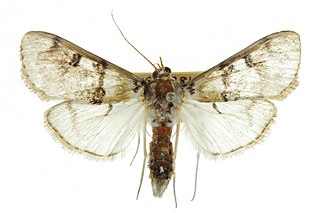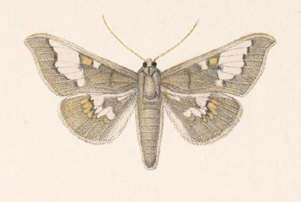
Correbidia elegans is a moth of the subfamily Arctiinae. It was described by Herbert Druce in 1884. It is found in Mexico and Panama.
Abegesta remellalis, the white-trimmed abegesta or white-trimmed brown pyralid moth , is a moth in the family Crambidae. It was described by Herbert Druce in 1899. It is found in Mexico and the south-western United States, where it has been recorded from Arizona, California and New Mexico.

Laniifera cyclades is a species of snout moth in the family Crambidae. It was first described by Herbert Druce in 1895, based on three imagines collected in Mexico City and near Durango City, Mexico. The species is also found in the states of Arizona and Texas in the United States.
Bocchoris darsanalis is a moth in the family Crambidae. It was described by Herbert Druce in 1895. It is found in Mexico (Jalapa) and Panama.
Hileithia apygalis is a species of moth in the family Crambidae. It was described by Achille Guenée in 1854. It is found in Colombia, Panama and Tabasco, Mexico.
Hileithia rhealis is a species of moth in the family Crambidae. It was described by Herbert Druce in 1895. It is found in Guerrero, Mexico.
Meroctena zygialis is a moth in the family Crambidae. It was described by Herbert Druce in 1899. It is found in Xalapa, Mexico.
Pantographa idmonalis is a moth in the family Crambidae. It was described by Herbert Druce in 1895. It is found in Morelos, Mexico.
Polygrammodes croesus is a moth in the family Crambidae. It was described by Herbert Druce in 1895. It is found in Guatemala.
Polygrammodes cyamon is a moth in the family Crambidae. It was described by Herbert Druce in 1899. It is found in Oaxaca, Mexico.
Psara prumnides is a species of moth in the family Crambidae. It was described by Herbert Druce in 1895. It is found in Mexico, Costa Rica, Honduras and Panama.
Salbia tremulalis is a moth in the family Crambidae. It was described by Herbert Druce in 1899. It is found in Orizaba, Mexico.

Siga pyronia is a moth in the family Crambidae first described by Herbert Druce in 1895. It is found in Panama and Costa Rica.

Syllepte angulifera is a moth in the family Crambidae. It was described by Herbert Druce in 1895. It is found in Guatemala, Costa Rica, Panama and Mexico.
Syngamilyta samarialis is a moth in the family Crambidae. It was described by Herbert Druce in 1899. It is found in Costa Rica and Colombia.
Syntrita prosalis is a moth in the family Crambidae. It was described by Herbert Druce in 1895. It is found in Panama.
Neopreptos clazomenia is a moth in the family Eupterotidae. It was described by Herbert Druce in 1886. It is found in Panama.
Neopreptos marathusa is a moth in the family Eupterotidae. It was described by Herbert Druce in 1886. It is found in Costa Rica.
Hypercallia phlebodes is a moth in the family Depressariidae. It was described by Lord Walsingham in 1912. It is found in Guatemala.

Macara alydda is a moth of the family Megalopygidae. It was described by Herbert Druce in 1887. It is found in Costa Rica and Napo Province, Ecuador. The habitat consists of montane cloud forests.




